Source: Simrit Dhinsa, Simrit Dhinsa, Samuel Kiernan, Gabe Parker, Zack Pokorny, Galaxy; Translated by: 0xjs@ Jinse Finance
introduction
The first half of 2024 is a critical period for the Bitcoin mining industry, with significant changes in the economic situation and evolving market dynamics. Miners have experienced a roller coaster of economic changes, with a strong performance at the beginning of the year until the fourth Bitcoin halving event, which subsequently caused the hash price to fall to an all-time low. Despite these fluctuations, large miners have remained steadfast in their growth trajectory, and the post-halving economic downturn has spurred a series of M&A activities in the field as miners seek to consolidate and benefit from scale.
Additionally, the convergence of AI and high-performance computing (HPC) trends with Bitcoin mining presents an opportunity for miners to allocate capacity to meet the emerging and continuing exponential demand curve in AI/HPC. As the report title suggests, the value of a gigawatt has grown significantly as competition for land and power intensifies among Bitcoin miners, hyperscalers, and others. Those with near-term pathways to energy will be uniquely positioned to take advantage of trends in both industries.
In this report, we take a deep dive into the changing landscape of Bitcoin mining, beginning with an overview of the current state of mining economics before expanding into key themes post-halving, such as the changing capital markets landscape, the massive demand for power capacity, increased M&A activity, and projected H2 H1 H2 H2 H2 H2 H3 H4 H5 H5 H6 H6 H7 H7 H7 H8 H7 H8 H8 H9 ...
Key Takeaways
Mining difficulty dropped 10% from a peak of 88.1 T (implied hashrate 630 EH) to a post-halving low of 79.5 T (implied hashrate 569 EH) in early July, as hashrate hit a new all-time recent low. As of this writing, the difficulty is 82.0 T (implied hashrate 587 EH).
In the first quarter of 2024, listed mining companies raised a total of US$1.8 billion in equity capital, the highest amount raised in a single quarter in the past three years.
While mining companies have been raising capital through equity issuance in recent months, we expect debt capital markets to re-emerge in the second half of 2024 and 2025 as the value of available power capacity soars.
Miners that have secured approval for large-scale power capacity, procured long-term infrastructure, and have access to water and fiber optics are best positioned to take advantage of the AI revolution.
In our annual report, we estimated the hash rate target range to be 675 EH to 725 EH by the end of 2024. Now, we have increased the growth to between 725 EH and 775 EH, combining information from listed mining companies, seasonal trends and profitability analysis.
From January 1, 2024 to July 23, 2024, Bitcoin miners generated 12.97k BTC ($863M as of July 23, 2024) in transaction fees. Miners earned approximately 55% of the total fees in 2023 (23.4k BTC).
So far this year, over $460 million of transactions have been completed, mainly including site sales, reverse mergers and company acquisitions. We expect M&A activity in the industry to continue in the future.
market situation
Mining economy in the first half of 2024
The first half of 2024 can be described as a tale of two quarters. In the first quarter of 2024, miners enjoyed the best economics of the past two years. Driven by the rise in Bitcoin prices, the hash price averaged $0.094/TH during the quarter. The hash rate continued to climb steadily during the quarter to offset some of the increase in Bitcoin prices. The strong profit margins in the first quarter of 2024 are necessary to build cash balances before Bitcoin's fourth halving in the second quarter of 2024.
The mining economy remained strong in the second quarter leading up to Bitcoin’s fourth halving. During the halving, the much-anticipated launch of Runes triggered a storm of transaction fees for several days. In the week following the halving, miners generated significant transaction fee revenue, which we will explore further in the next section.
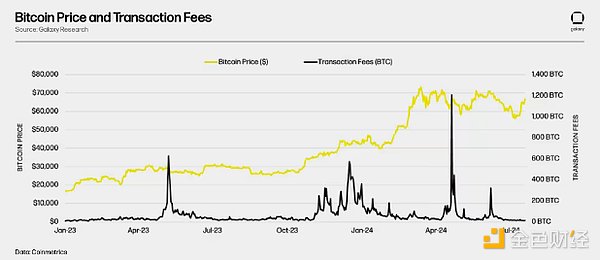 The transaction fee surge pushed the hash price up to $0.17/TH in a very short period of time, reversing the impact of the block subsidy reduction. Recall that the hash price is the preferred metric for miners to extract total revenue per TH of computing power per day. However, this surge was short-lived, and then the hash price hit a new all-time low after transaction fees stabilized. Since the halving, the hash price has averaged $0.054/TH.
The transaction fee surge pushed the hash price up to $0.17/TH in a very short period of time, reversing the impact of the block subsidy reduction. Recall that the hash price is the preferred metric for miners to extract total revenue per TH of computing power per day. However, this surge was short-lived, and then the hash price hit a new all-time low after transaction fees stabilized. Since the halving, the hash price has averaged $0.054/TH.
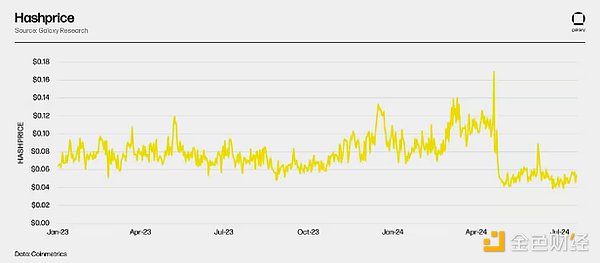
Mining difficulty dropped 10% from a peak of 88.1 T (implied hashrate 630 EH) to a post-halving low of 79.5 T (implied hashrate 569 EH) in early July as hashrate hit a new all-time low. As of this writing, the difficulty is 82.0 T (implied hashrate 587 EH).
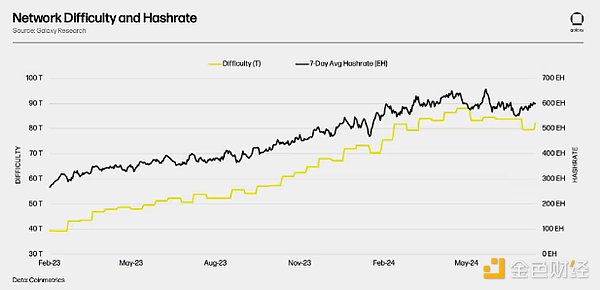 At current hash price levels, a significant portion of the network's miners remain profitable, but only marginally. Some miners who are on the sidelines may continue to operate as they can generate positive gross profits. However, when operating expenses and additional cash costs are taken into account, many miners find themselves unprofitable and slowly running out of cash. Strong economic conditions in the first quarter of 2024 have helped build cash balances, which has extended the survival of inefficient miners. Without a significant increase in Bitcoin prices or transaction fees, we expect some miners to exit the network if hash prices fall further.
At current hash price levels, a significant portion of the network's miners remain profitable, but only marginally. Some miners who are on the sidelines may continue to operate as they can generate positive gross profits. However, when operating expenses and additional cash costs are taken into account, many miners find themselves unprofitable and slowly running out of cash. Strong economic conditions in the first quarter of 2024 have helped build cash balances, which has extended the survival of inefficient miners. Without a significant increase in Bitcoin prices or transaction fees, we expect some miners to exit the network if hash prices fall further.
Even if this happens, the downward pressure on network hashrate due to unprofitable miners shutting down machines will be offset by the addition of a new generation of application-specific integrated circuits (ASICs) that have a nominal hashrate of more than twice that of previous generations. Seven of the top ten public miners by market cap are expected to add another 109 EH in H2 2024. As we analyze at the end of the report, we believe hashrate will rise significantly in H2 2024 despite the recent halving. This will create headwinds for miners if the price of Bitcoin does not rise.
Transaction Fees Fluctuate
Since January 1, 2024, Bitcoin has facilitated over 99 million on-chain transactions. Of these 99 million transactions, 50% are standard transactions, which we define as financial transactions. Runes, BRC-20, and Ordinal transactions account for 35%, 11%, and 4% of the volume, respectively. The 35% market share of Rune-related transactions in total volume is significant considering the launch of the Fungible Token Protocol on April 19, 2024. Since its launch, Runes have accounted for an average of 63% of all Bitcoin transactions.
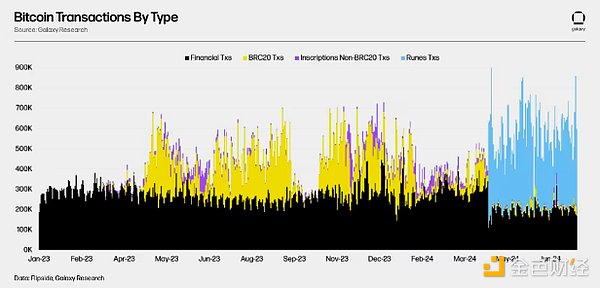 From January 1, 2024 to July 23, 2024, Bitcoin miners generated 12.97k BTC ($863M as of July 23, 2024) in transaction fees. Miners earned about 55% of the total fees in 2023 (23.4k BTC). Bitcoin’s fourth halving occurred on April 19, 2024, making 2024 a landmark year. On the day of the halving, daily fees paid to miners surged to an all-time high of over 1,200 BTC. This surge was largely due to the launch of Runes, a new UTXO-based fungible token protocol that debuted on the halving block. On this block, the Rune token XXXXFHUXXXXXX paid $23M in fees to become the first Rune set included in the halving block (block 840,000). Notably, 2,411 BTC (19%) of fees generated year-to-date came on the halving day and the three days that followed.
From January 1, 2024 to July 23, 2024, Bitcoin miners generated 12.97k BTC ($863M as of July 23, 2024) in transaction fees. Miners earned about 55% of the total fees in 2023 (23.4k BTC). Bitcoin’s fourth halving occurred on April 19, 2024, making 2024 a landmark year. On the day of the halving, daily fees paid to miners surged to an all-time high of over 1,200 BTC. This surge was largely due to the launch of Runes, a new UTXO-based fungible token protocol that debuted on the halving block. On this block, the Rune token XXXXFHUXXXXXX paid $23M in fees to become the first Rune set included in the halving block (block 840,000). Notably, 2,411 BTC (19%) of fees generated year-to-date came on the halving day and the three days that followed.

Since January 1, 2024, 67% of miner fee revenue has come from Standard Finance transactions, while 19% has come from Runes. BRC-20 and Ordinals transactions together account for 14% of Bitcoin fees year-to-date.
 "Overpayment" refers to the amount of fees (in sats/vByte) for transactions in a block that is higher than the median sats/vByte for the same block. We choose the median sats/vByte level for a block because we believe that bidding around this level will give you a reasonable chance of being included in the next block if you are a high time preference user. Transactions that intentionally set higher sats/vByte rates are often time sensitive. During Bitcoin's fourth halving on April 20, 2024 (UTC), transaction fees spiked significantly. The median daily fee rate reached 590 sats/vByte, and within an hour of the halving block, the average median block fee rate spiked to 1,840 sats/vByte. Rune-related transactions paid fees that were 250 sats/vByte higher than the median sats/vByte level for the day (42% higher than the median sats/vByte) to be included in the halving block and several blocks after it. During the same period, Standard Finance transactions paid 200 sats/vByte more in fees than the median sat/vByte (34% more than the median sat/vByte). Since the halving, Standard Finance transactions have paid 51 more days than Rune transactions in fees, while Rune transactions have paid 18 more days than Standard Finance transactions in fees.
"Overpayment" refers to the amount of fees (in sats/vByte) for transactions in a block that is higher than the median sats/vByte for the same block. We choose the median sats/vByte level for a block because we believe that bidding around this level will give you a reasonable chance of being included in the next block if you are a high time preference user. Transactions that intentionally set higher sats/vByte rates are often time sensitive. During Bitcoin's fourth halving on April 20, 2024 (UTC), transaction fees spiked significantly. The median daily fee rate reached 590 sats/vByte, and within an hour of the halving block, the average median block fee rate spiked to 1,840 sats/vByte. Rune-related transactions paid fees that were 250 sats/vByte higher than the median sats/vByte level for the day (42% higher than the median sats/vByte) to be included in the halving block and several blocks after it. During the same period, Standard Finance transactions paid 200 sats/vByte more in fees than the median sat/vByte (34% more than the median sat/vByte). Since the halving, Standard Finance transactions have paid 51 more days than Rune transactions in fees, while Rune transactions have paid 18 more days than Standard Finance transactions in fees.
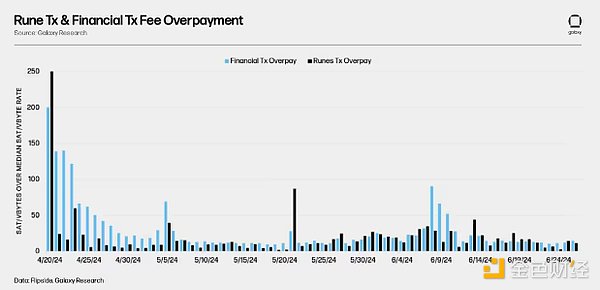
Overlaying the daily number of Rune transactions with the above graph, we see that surges in Rune transactions are positively correlated with surges in financial transaction overpayments. Time-sensitive financial transactions are forced to compete with Rune transactions for block inclusion. While there are days when Rune transactions surge and Rune transactions overpay for block inclusion, these are considered outliers associated with specific Rune token mints.
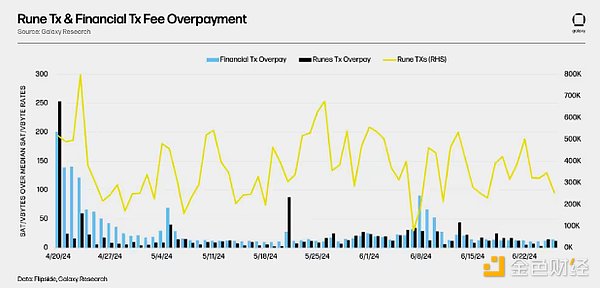
Analyzing the data on a block-by-block basis shows that within a 10-minute interval, standard financial transactions differ in frequency from Runes transactions. Since the halving block (block 840,000), financial transactions have averaged 2.4 MB per block, while Runes transactions have consistently taken up about 1.5 MB of block space. Although Runes are a more efficient homogenous token standard than BRC-20 (average 0.06 MB per block), the dominance of Runes over BRC-20 in terms of block space highlights the market preference for the Rune token standard. In the halving block, Runes transactions consumed 2.7 MB, or about 68% of the total space at block 840,000.
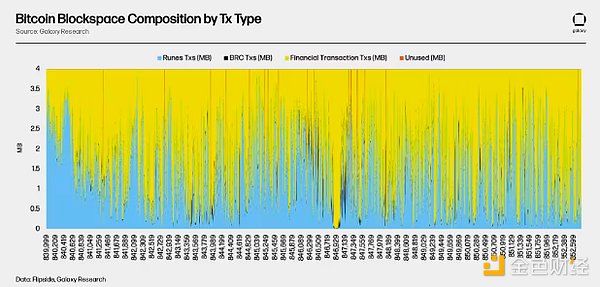
Growth/Infrastructure
The changing capital market landscape
In the first half of 2024, miners raised unprecedented amounts of money. Since the fourth quarter of 2023, when valuations began to surge in anticipation of the approval of a spot Bitcoin ETF, miners have continued to raise funds (mostly equity) to rapidly scale up until the halving. In the first quarter of 2024, listed mining companies raised a total of $1.8 billion, the highest amount raised in a single quarter in the past three years.
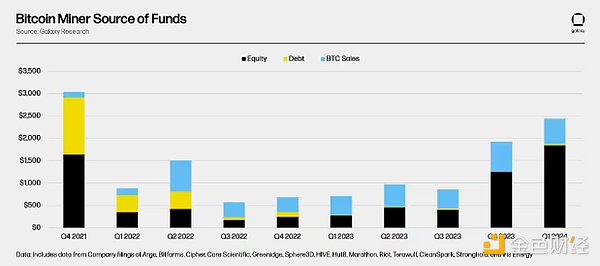
Prior to the halving, miners actively raised funds to support rapid growth, hold Bitcoin, improve mining machine efficiency, and build cash buffers to take advantage of opportunities in difficult times. Of the $1.8 billion raised, 75% came from the top three miners by market capitalization: Marathon, CleanSpark, and Riot. The launch of a new generation of mining machines by Bitmain and MicroBT at attractive prices further increased the urgency of miners to expand capacity and insert mining machines as soon as possible to generate a strong return on investment ("ROI").
As shown in the above chart, debt capital has largely disappeared from the market since mid-2022. Previously, the debt financing options available to miners were primarily centered around collateralizing ASICs. The challenges with ASIC-backed financing are volatile ASIC pricing, rapid depreciation of collateral, and the absence of margin calls in many contracts. When mining conditions deteriorate, not only do machines generate less cash flow, but their value also decreases, and as LTV rises, miners are unable to repay outstanding debts, putting lenders in a precarious position.
However, as the value of available power capacity surges, we expect lenders to re-enter the market in the second half of 2024 and into 2025. The insatiable demand for power capacity from Bitcoin miners and hyperscalers (i.e., large data centers with scalable cloud infrastructure) has driven up the value of available energy capacity. From a lender’s perspective, underwriting debt for miners with access to large-scale power capacity in favorable locations can provide insurance in the event that mining economics deteriorate. Additionally, during 2022 and 2023, miners are focused on strengthening their balance sheets by reducing outstanding debt and creating leaner cost structures. As a result, we believe the industry is now in a better position to take on some debt rather than relying solely on issuing equity for growth.
Power assets are still in a period of price discovery. Recent asset sale prices have ranged widely, but have generally trended upward. From a mining company perspective, capitalizing on the rising value of their sites is attractive at a project level, a non-dilutive alternative and a differentiator from peers who continue to dilute shareholders as a primary source of capital.
Focusing on generating free cash flow and creating a lean structure while combining debt with cash flow sweeps can allow miners to grow in a capital efficient manner. Expanding into AI and high performance computing can also open the door to new sources of debt capital that are not available to pure miners.
Even as debt opportunities grow, the expansion “arms race” continues, and we expect large-scale equity financing activity to continue through the second half of 2024. Publicly traded miners’ valuations have risen, driven by ambitious growth targets, the prospect of future Bitcoin price increases, and the AI/HPC narrative. These rising valuations help miners reduce shareholder dilution from equity offerings. As large publicly traded miners announce ambitious targets, expansion and financing activity does not appear to be slowing down, even as hash prices remain near historic lows.
Millions of dollars worth of MW
Miners are riding the crest of a growing trend at the convergence of Bitcoin and AI/HPC. Miners remain thinly profitable given the non-linear correlation of operating costs to BTC prices, and remain well-positioned to benefit from a continued bull run in Bitcoin prices. Meanwhile, generative AI is one of the fastest growing technologies in history. ChatGPT, for example, had 100 million users in its first two months after launch, becoming the fastest growing application in history. Coupled with the fact that the power required for AI model training and inference is an order of magnitude higher than that used by traditional data centers (a single query on ChatGPT requires 10 times the power of a Google search), the AI arms race has created a staggering need for reliable power at short notice.
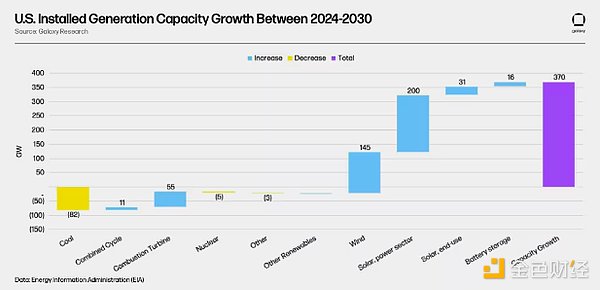 Global data center demand is expected to grow 160% by 2030. Currently, U.S. data center demand is estimated at 21 GW and is expected to grow to 35 GW by 2030. U.S. installed power generation capacity is expected to increase by approximately 370 GW during the same period. However, as shown in the above chart, the U.S. Energy Information Administration (“EIA”) projects a net reduction in dispatchable generation sources (coal, natural gas, nuclear, etc.), which means that non-dispatchable, intermittent generation sources (wind, solar, etc.) will largely fill the expected supply and demand gap. Therefore, if this is converted to terawatt hours (“TWh”), power generation is expected to increase by 240 TWh, while new data center load (assuming 99.995% uptime) will increase by 123 TWh (14 GW / 1000 * 8,760 hours/year * 99.995%). The increase in intermittent generation sources, combined with growing demand from inflexible data center loads, could lead to grid congestion, transmission constraints, and supply shortages as load from other industries, such as electric vehicles and domestic industrial manufacturing, are expected to grow. This could lead to further delays in load interconnection studies, approved ramp plans, and facility agreements as grid operators assess the rapidly growing U.S. electricity demand relative to generation growth. In a recent interview with the Dwarkesh Podcast, Mark Zuckerberg noted that gigawatt data centers do not exist yet and that “right now it’s about securing energy,” which is the biggest bottleneck in the AI supercomputer-driven race. The race for power capacity is on, and Bitcoin miners with large-scale power, continuous land, water, and fiber connections are best positioned to take advantage of this megatrend.
Global data center demand is expected to grow 160% by 2030. Currently, U.S. data center demand is estimated at 21 GW and is expected to grow to 35 GW by 2030. U.S. installed power generation capacity is expected to increase by approximately 370 GW during the same period. However, as shown in the above chart, the U.S. Energy Information Administration (“EIA”) projects a net reduction in dispatchable generation sources (coal, natural gas, nuclear, etc.), which means that non-dispatchable, intermittent generation sources (wind, solar, etc.) will largely fill the expected supply and demand gap. Therefore, if this is converted to terawatt hours (“TWh”), power generation is expected to increase by 240 TWh, while new data center load (assuming 99.995% uptime) will increase by 123 TWh (14 GW / 1000 * 8,760 hours/year * 99.995%). The increase in intermittent generation sources, combined with growing demand from inflexible data center loads, could lead to grid congestion, transmission constraints, and supply shortages as load from other industries, such as electric vehicles and domestic industrial manufacturing, are expected to grow. This could lead to further delays in load interconnection studies, approved ramp plans, and facility agreements as grid operators assess the rapidly growing U.S. electricity demand relative to generation growth. In a recent interview with the Dwarkesh Podcast, Mark Zuckerberg noted that gigawatt data centers do not exist yet and that “right now it’s about securing energy,” which is the biggest bottleneck in the AI supercomputer-driven race. The race for power capacity is on, and Bitcoin miners with large-scale power, continuous land, water, and fiber connections are best positioned to take advantage of this megatrend.
While there are many differences between Bitcoin mining and AI data centers, miners are most likely to enter the AI/HPCC data center market from a time-to-market perspective. Most of the core electrical infrastructure is similar to that used in traditional data centers, from high-voltage substation components to downstream medium- and low-voltage distribution systems. Some electrical components, including main power transformers and gas circuit breakers, have very long lead times, giving miners who procure these assets a competitive advantage over new entrants who face 3-4 year procurement times.
Miners have the land and power infrastructure needed to build the next generation of the world’s largest data centers. Data center developers and hyperscalers will likely begin bidding on these parks to secure large-scale power quickly. This trend is just beginning, with CoreWeave’s $1 billion acquisition of Core Scientific being an obvious first mover. As the traditional data center market and colocation providers become increasingly saturated, hyperscalers will be forced to push boundaries and move further into secondary and tertiary markets for both brownfield and greenfield developments.
Miners began to dabble in AI/HPC in 2023, but the 200 MW hosting deal struck by CoreWeave and Core Scientific in June 2024 caught the industry off guard. Before the AI boom, the value of these “mega-sites” owned by large miners was purely for their Bitcoin mining potential. However, the impact of the CoreWeave deal on Core Scientific’s share price proves that miners can benefit from AI advantages. The chart below shows that miners who have taken steps to adopt a hybrid mining/AI approach have benefited significantly compared to those who have remained focused on a pure mining strategy.
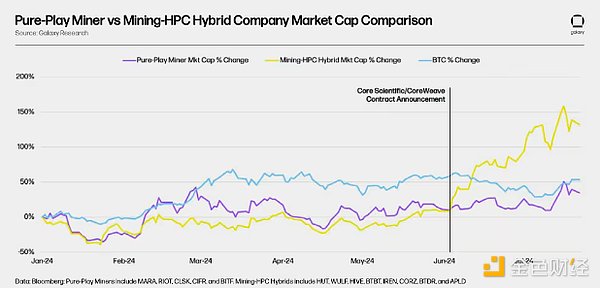
This advantage exists because the economics of AI/HPC contracts are favorable as of today. If you boil it down to a dollar/MWh (“$/MWh”) figure, the latest generation of Bitcoin mining machines generate electricity for approximately $125/MWh (S21, hash price of $0.053/hash/day), fluctuating with changes in hash price. Assuming a $40/MWh electricity cost, the gross profit per MWh is $85/MWh. In contrast, as part of the Core Scientific/CoreWeave transaction, CoreWeave is willing to pay a fixed $118/MWh, as well as pass-through electricity costs for 280 MW (graphics processing units (“GPUs”) + IT and mechanical cooling infrastructure), for Core Scientific to provide the hosting service, even after paying for the majority of the CapEx investment.
If the market continues to reward miners pursuing AI/HPC opportunities, we believe the number of pure Bitcoin miners with large sites will decrease in the future, especially if hash prices remain low.
As of July 22, the total market capitalization of the companies in the above chart (pure + hybrid) is $28.2 billion. When you compare this number to the capital pouring into AI (as shown in the chart below), it is hard to imagine that well-positioned miners will not turn to hybrid approaches in the future. As computing demand grows, hyperscalers including Amazon, Microsoft (Stargate, Wisconsin, Sweden), Google, and others have announced plans for massive growth in AI in the coming years.
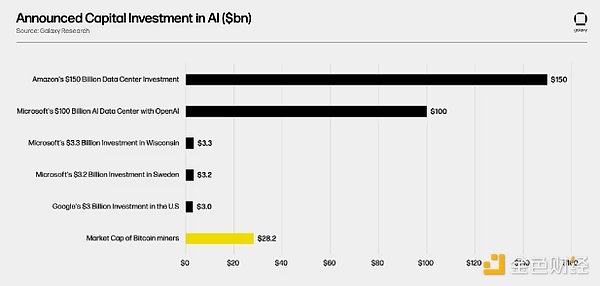 Some Bitcoin miners are already benefiting from AI. However, until miners prove they can build and operate these data centers at scale, they will continue to undercut pure data center providers.
Some Bitcoin miners are already benefiting from AI. However, until miners prove they can build and operate these data centers at scale, they will continue to undercut pure data center providers.
Merger and Acquisition Summary
Throughout 2024, Bitcoin miners have participated in a large number of M&A transactions. As predicted in our previous report, the M&A trend has remained consistent. Miners are increasingly vertically integrating by acquiring sites to increase input control. To date, the transaction volume of various transactions has exceeded $460 million, mainly divided into site sales, reverse mergers, and company acquisitions. Record low hash prices and steep ASIC efficiency curves have forced miners to adopt a more strategic approach to achieve higher operational excellence. Some of the motivations for the large-scale M&A observed in 2024 include:
Vertical Integration: The asset-light era is fading. Previously, miners would host their entire fleet of mining machines at a fixed electricity price, sacrificing the flexibility to optimize operations for cost efficiency. With hash prices hitting record lows after the halving, this has forced miners to vertically integrate more than ever, allowing them to manage the bleak hash price conditions and declining mining economics through economic cuts or reduced operating overhead. In 2024, more than 1.1 GW of power access has changed hands, indicating that miners are gaining more control over their operations. Public miners invest approximately $404,000 per MW for power access, covering current and future needs.
Business Consolidation: The public mining industry has seen notable transaction types, highlighting reverse mergers as many mining operations were previously sustained by traditional fixed-rate agreements that are no longer economically viable, triggering widespread consolidation.
Diversification: 2024 is the year of seeking synergies through diversification, whether it is geographic expansion into emerging markets with lower energy costs or diversifying revenue sources outside of mining. For example, Bitdeer’s acquisition of ASIC design company Desiweminer embodies this strategy, acquiring internal expertise to drive the launch of their proprietary ASICs, allowing them to gain another revenue stream outside of Bitcoin mining.
Future M&A opportunities
For miners who do not upgrade their mining machine efficiency or are unable to adjust their costs after the halving, we may see an erosion of liquidity, depleting their capital reserves as they seek an exit or wait for acquirers to take advantage of their distress. If the hash price remains below $0.06/TH for a long time, we may see an increase in the number of distressed products, as was the case in late 2022. At this hash price level, there is little room for profit beyond the price of electricity, let alone considering related operating expenses, depreciation, and any outstanding interest. For example, at current hash price levels, some of the most popular previous generation machines, especially the Antminer S19j Pro, generate USD/MWh revenue of about $70/MWh. At an average electricity price of $60/MWh, there is little room to consider all other related costs when addressing the miner's bottom line.
Despite the shaky financial situation of some miners, miners with power assets could be attractive acquisition targets. The demand for power in the high-performance computing sector continues to grow. For example, hyperscalers face a shortage of power capacity relative to the demand for their services and are willing to pay a large premium to do so. Earlier this year, Amazon AWS purchased capacity for $677,000 per megawatt, significantly higher than the average mining transaction cost per megawatt in 2024. Asset-intensive miners act as a proxy for power acquisition as grid interconnection schedules within the United States remain tight and demand for AI remains strong. It will be interesting to note how many power connections the hyperscalers are prepared to bid for.
Access to affordable capital remains a challenge for smaller private miners. Even if debt markets reopen, debt service rates may remain inadequate. These miners may consider a reverse merger with a public company to take advantage of offerings in the market.
Evaluating attractive prospects
Factors that influence a company’s market value are constantly changing, providing choices when narrowing down the attractiveness of targets. This choice comes primarily from changes in the power market, the premium given to public companies based on their strategies, and access to capital. Evaluating desirable targets can sometimes seem like a cat-and-mouse game, trying to understand market value and anticipate waves of demand. Here is a list of some of the characteristics that make a target attractive:
Readily available capacity: Miners that not only have existing power capacity, but also a healthy, approved power pipeline with a clear path to power on may become attractive targets; “lip service” will not work. The same is true for smaller miners that cannot achieve scale, cannot upgrade their equipment, or operate on thin margins, but have valuable power assets that could be more profitable by deploying more efficient machines or moving to AI/HPC.
Contracted Predictable Revenue: Letters of Intent (“LOIs”) and term sheets do not emphasize stability. Miners who contract revenue for a certain period of time receive a constant stream of cash. Given the speculative nature of mining economics, miners are inherently subject to hash price fluctuations, so it is wise to diversify their revenue streams.
Previous Generation Machines: When considering ASIC price speculation, many miners with less efficient machines can sell their ASICs at a discount to some of their peers with more efficient machines. This can make the $/TH price attractive, providing a good price entry point for the ROI of these secondary machines. Some previous generation machines (30 j/TH) are selling at attractive prices, whether you want to mine (at a low cost) or speculate on resale. While this may not generate value appreciation in the context of achieving high multiples, it can quickly pay off while keeping the option of future machine upgrades.
Essentially, some miners can be valuable targets for companies with high computational needs to quickly acquire scalable power. This is especially true for miners that have large interconnection agreements, access to power infrastructure growth, and ample space. Having this trifecta can increase the dollar/MW premium that miners can earn by selling such capacity. As demand for computational power continues to grow, we will be excited to see how this affects the valuations of miners and their attractiveness as investment prospects.
Hash rate prediction
In our annual report, we estimated a range of 675 EH to 725 EH for the end of 2024 hashrate target. We are now revising that upward to between 725 EH and 775 EH. To arrive at our revised estimate, we looked at a subset of publicly traded miners and their hashrate targets to see what we know is a reasonable probability of the number of miners coming online this year and extrapolated that to the rest of the network. We also analyzed historical hashrate seasonality as an additional baseline. To complete the analysis, we analyzed network breakeven points to validate the range.
First, we will look at the hashrate growth of listed miners in the second half of 2024. In the first half of 2024, listed miners placed large purchase orders for new generation machines, helped by soaring valuations and huge capital raised in the stock market. The table below summarizes the hashrate figures achieved in June, the targets for the end of 2024, and the implied hashrate growth for some listed miners in the second half of 2024. In total, assuming that each miner reaches the set target, these listed miners are expected to stimulate 109 EH of incremental hashrate, which means that only 7 miners can bring about 18% network hashrate growth.
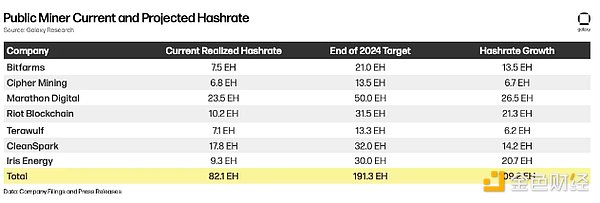 Next, to estimate the growth of the rest of the network, we analyzed the trend of hashrate of this group of listed miners relative to the rest of the network. As shown below, historically, this group of listed miners has accounted for 11%-13% of the network.
Next, to estimate the growth of the rest of the network, we analyzed the trend of hashrate of this group of listed miners relative to the rest of the network. As shown below, historically, this group of listed miners has accounted for 11%-13% of the network.
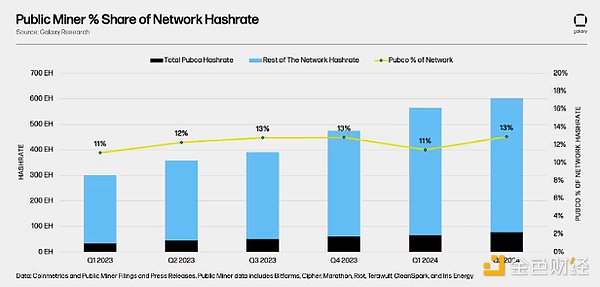
An oversimplified way to do this is to divide 109 EH by 13% to arrive at a phenomenal 838 EH growth for the rest of the network. However, this assumes that public miners will continue to hold 11-13% of the network. The scenario table below shows what the year end hashrate would be if we changed the public miners’ share of the year end hashrate and assumed a current network hashrate of 587 EH, a public miners’ hashrate growth of 109 EH, and a current public miners’ share of the network hashrate of 13%.
We estimate that the share of the network held by public miners will grow to closer to 15%-30%, with a baseline of 25%. This is because public miners have access to U.S. capital markets and were able to raise significant amounts of capital in Q1 2024, a huge advantage over private miners. At a 25% share of hashrate at year end, this would imply a total network hashrate of 741 EH, implying that the rest of the network would add 45 EH of growth in H2 2024.
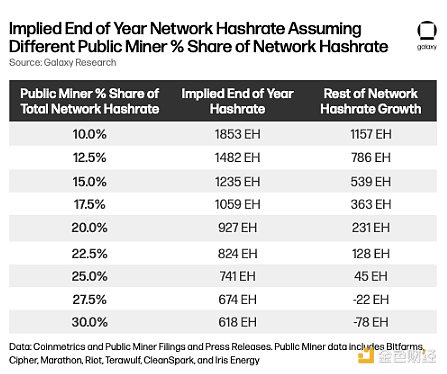
So strictly from a public mining company perspective, this puts our baseline for hashrate growth at 741 EH. We expect a fair amount of additional hashrate to come online in the second half of this year, which we believe is feasible through both machine replacements and net new capacity coming online. Recalling the analysis we performed in our last annual report, the sensitivity table below shows what the network hashrate would be under different combinations of replacement network percentages and additional GW of capacity expansion. We start with 587 EH of network hashrate, assuming an efficiency of 17.5 J/TH for new machines inserted and 30 J/TH for machines replaced.

We assume S21 deployment in the table above, but looking beyond 2024, the table highlights the impact on network hashrate of simply replacing older generation machines with newer generation machines. Combined with announcements from new ASIC manufacturers indicating that Bitcoin mining ASICs could reach 5 J/TH efficiency next year, this would provide another meaningful boost to network hashrate in 2025.
The next part of our analysis looks at historical hashrate trends throughout the summer and at the end of the year. As shown in the chart below, hashrate generally remains stable during the summer months of July to September. This is likely due to the increasing proportion of the network located in Texas and the Middle East, where miners have to reduce frequency due to high temperatures. Additionally, miners in Texas are constrained due to price volatility, avoiding the quadruple peak (4CP), and participating in demand response programs.
After the summer, network hashrate began to surge as uptime increased, the need for throttling decreased, and miners plugged in new machines. Public mining companies are expected to increase hashrate significantly in the second half of the year, and we expect a similar dynamic this year, with network hashrate increasing slightly in the summer and then accelerating rapidly towards the end of the year.
The network difficulty in 2024 follows a similar growth trajectory as 2022 and 2023. The difficulty in 2024 moves in lockstep with the difficulty trend in 2022. In 2022, the difficulty increased 14% from September to the end of the year, from October to the end of the year. In 2023, the difficulty increased 29% from September to the end of the year. If we apply these growth rates to the current network hashrate of 587 EH, this implies a range of 670 EH to 760 EH. While the targets we have previously derived from public miners are at the high end of this range, it gives us confidence in what is feasible from an infrastructure build perspective.
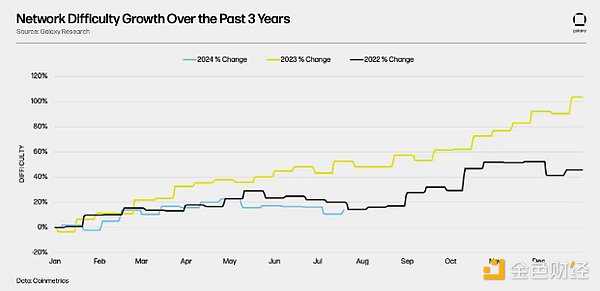
The final analysis is to understand the implied hash price based on our target hashrate to understand the price at which the network is economically sustainable. Several variables affect this sensitivity analysis, including Bitcoin price, transaction fees, average network electricity prices, and network efficiency levels. Given the volatility of transaction fees, we assume they remain fixed at 10% of the block subsidy (0.3125 BTC) per block.
For the average network electricity price, we analyzed the recent downward trend in hashrate to understand the marginal unit of electricity price. After the halving, it was adjusted downward by 5.62%, and the hashrate dropped to $0.052. Using Coinmetrics' MINE-WATCH, the estimated average network efficiency is 33.3 J/TH, which means the average network electricity price is $65/MWh.
As the network hashrate grows, the mix of machines will become increasingly efficient. Therefore, we assume a 20% improvement in network efficiency (lower J/TH), bringing the network efficiency to 26.6 J/TH. At these efficiency levels, the network’s breakeven hash cost would be $0.041/TH if electricity prices remained constant at $65/MWh. While hash price quantifies revenue per TH of computing power, hash cost shows the total energy cost per TH. If we consider Bitcoin price and network hashrate, and assume transaction fees are fixed at 10% of the block subsidy, the chart below shows the average gross margin for the network. Assuming Bitcoin prices remain in the $65,000 to $70,000 range, the network can still support 741 EH of hashrate, further confirming that these levels are economically sustainable.
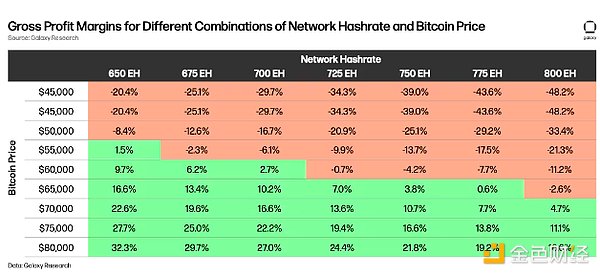
In summary, our initial hashrate target is 741 EH, based on growth target information we receive from public mining companies, seasonal comparisons to prior years, and economic analysis. We create a range of 725 EH to 775 EH around this number due to uncertainty in machine deployment. We recognize that there are many factors that could cause deviations from this range. On the upside, improved mining economics and faster-than-expected machine releases and deployments could push us above 775 EH. On the downside, further deterioration in hashrate or a significant shift of capital from Bitcoin mining to AI/HPC could slow growth.
in conclusion
The first half of 2024 marks a defining period for the Bitcoin mining industry, one that has seen significant economic challenges and groundbreaking developments. Despite record low mining economics, the industry has demonstrated remarkable resilience and adaptability in the face of historically low hash prices and high electricity demand.
The convergence of AI/HPC and Bitcoin mining represents a transformative new endeavor for many companies as they seek to take advantage of the industry’s robust, uncorrelated economics.
With the growing demand from AI/HPC data centers and miners, power supply is now clearly a bottleneck. Therefore, miners with large power supplies are in a good position to stand out, and it is critical for these miners to maintain flexibility in the future and allocate megawatt capacity in the direction that maximizes shareholder returns.






